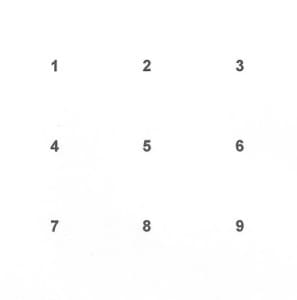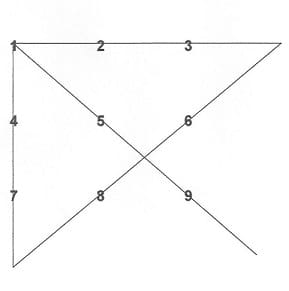
From Chapter 12 of Mary Bast and Clarence Thomson’s Out of the Box Coaching with the Enneagram, 4th Edition, available at Amazon.com in 
Not only clients get stuck in boxes. So do coaches. Each Enneagram style has a corresponding coaching style that will be intuitive and comfortable – and will require breaking out of your own box.
Remember the Nine-Dot Problem where you’re asked to connect nine dots with only four straight lines?

We’ve used numbers instead of dots so this riddle can serve as a metaphor for you as a coach: how to go beyond the limitations of Enneagram habits – yours as well as clients’.
Many people who see this puzzle for the first time can’t figure out how to connect all nine points with four straight lines because they assume they must stay within the visually implied box. There is no box in the diagram, as you can see, but our generic worldview is one of boxes. The only way to solve this problem is to go outside the box, in this case by creating four lines that extend past the numbers:

Your clients can step out of their habitual patterns; so can you, whether in the initial call or during the coaching process. The Enneagram tells you, with more detail and precision than you may find comfortable, what kind of box you may be in. Every Enneagram style is the over-use of a gift. What is your gift and how do you over-use it? Use other styles as models – how people motivate, challenge, unite, support, protect, and advise others. You will unearth a whole treasure chest of differing approaches. Each approach will at least partially teach you how you can coach outside your own box. Compare your approach to the eight others, become more self-aware, and notice how the Enneagram points to your growing edge.
Style One Coaches
These coaches are great at holding clients to demanding standards. Observing them may remind you of your best and strictest teacher. They can critique with surgical precision. Watch how helpful exact feedback can be, especially when balanced with a healthy style One’s infectious idealism, which can bring out the best in their clients. They model how to hold a vision of what’s possible.
On the other hand, these coaches are apt to take some of the pressure off the need for individual change and shift it to how to function within the system. This is fine for first-order change but, if this is your Enneagram style, you may need to hold your focus to your clients’ transformational needs. If you have a set of standards you want your clients to meet, you’ll find yourself trying to convince them what they ought to do. Because you’re highly motivated to do what’s right, you may wrongly assume the same motive will energize your clients. This can be a turn-off, especially in the introductory call, when they can’t yet hear the caring behind your criticism. Style Threes, for example, do not respond to the slogan, “Virtue is its own reward.” They’ll want to see some kind of tangible reward. If you stay within your box, you’re apt to think of clients like these as less than noble.
Style Two Coaches
When you watch these coaches, you’ll notice first the emotional support they offer. Attuned to every mood, spoken and unspoken, they know what to say to support a struggling client. Notice, too, how accepting and understanding they are. Clients are sure the coach is on their side. Listen to their advice on networking, diplomacy, and motivation. These are what they do best.
If you’re a style Two, you think coaching is a great idea. You’ve been helping people all your life and now they’re paying you for it! And you know just what a client needs. You have this little irritation – not large, you understand – when they won’t do what’s good for them. You’re such a wonderful listener you may feel sure they owe obedience to your suggestions for the time you spent in rapt attention. You may have to be a little clever, even devious, but they’ll realize you have their best interests at heart. Maybe. Your temptation is to manipulate people into doing what you think they need. You may especially be tempted to do this to get them to hire you. And if you’re really in your box, you will make them dependent on you and your marvelous suggestions. Watch for your conviction in the initial session that what they really need is you.
Style Three Coaches
Even if your relationship with clients is going well, you may still need to sharpen your skills in setting goals and objectives, measuring progress, and helping your clients achieve the results they need. If so, go see a style Three in action. And we mean action. Measurable results are their specialty. They can help clients act effectively and get applause, and will also anticipate what behavior will get a client in trouble. Few coaches are more in tune with the corporate culture, but they can also be models for making rapid progress with personal goals. If you can’t find a live coach to model from, read some books on time management – usually advice on how to be good Threes, written by Threes for Three aspirants.
If this is your Enneagram style, you probably assume the standard motivation of fame and fortune at the top of the heap. You believe you’ll succeed if you play your role well. This doesn’t work for many of your clients, even when they say they want to do a good job. You may not leave nearly enough room for the subjective and interior dimensions of life (go to style Four coaches for this inspiration). You’ll have to work hard to get inside the world of your clients, especially in the initial session, when your every molecule is screaming, “Get the sale! Get the sale!” Pay attention to the process rather than focusing, laser-like, on the goals. You may also need to work on your tendency to define your own success by clients’ approval. Really good drivers dim their headlights so others can see by theirs. Let your clients shine.
Style Four Coaches
Now watch some style Four coaches. When healthy, they trust their take on things without losing sight of the client’s novel circumstances. Notice their empathy, which gives clients faith they’re in good hands while experimenting with innovative approaches to resolving problems. Nobody so well appreciates subjectivity. They’re masters of the unique: This jacket is you, This job only you can do; Forget the system, do what feels right inside. They have intuitive insight into the individual, as opposed to understanding the system the way style One or Three might. “Objectively, Beethoven was the greatest. But subjectively Tchaikovsky is perfect for you because you’re style Four and so was he.” That kind of appreciation of the individual is this coaching style’s gift. Notice how they’re careful never to make clients an example of a trend. They’ll teach clients how to follow the book as far as they need to, then put it down gracefully and address their unique self and situation.
If this is your Enneagram style, you may try too hard in the first call to come up with daring and original solutions to impress clients as the most creative of coaches. Later in the process, you may find their mundane concerns a bit boring. You may not pay enough attention to the real criteria they have to face. Others’ expectations may be terribly important to them and you might have trouble seeing why. After all, one should work according to one’s own lights. You have to establish trust before clients can appreciate your unusual approach.
Style Five Coaches
Look in on style Fives, the master planners. Watch how they allow plenty of time to think things through. Their clients know everything they say will be noticed and reflected on. Pay attention to how well these coaches prepare. They’ll have notes and comments from last time, possible references, and resources. They’ll have relevant useful information and the session planned out quite thoroughly in their heads. Then see how objective and balanced is their advice. For cool wisdom, you can’t beat them.
If this is your Enneagram style, you might be surprised when clients don’t use information you give them. You know, in your head of heads, that information is the key to solutions. If that’s the way you think about it, you might have some trouble understanding that the process of helping someone work through a block can be primarily emotional. Even in the initial call, their emotional state is important information. Counter your tendency to sell them on your expertise. Good coaches form an emotional alliance that is an understanding of deep mutual trust. You can learn much from all the other styles, but especially from the healthy style Two’s emotional intelligence. You may also need to be feistier, more connected with others, at which style Sixes can excel.
Style Six Coaches
If you don’t like trouble (or troubling emotional interaction), spend some time with these talented coaches. Look closely, and you’ll see they look closely too. They examine every process, every decision, and every person or idea to see what might be dangerous or stupid or expensive. If you want to learn how to avoid problems by thinking of them ahead of time, observe how they do this with amazing thoroughness. They help clients discover all the things they have to watch out for to make sure their ideas work. They’ll also doubt or challenge much of what clients say, so the client can become more honest and self-aware during the process. This is a gift in on-going coaching.
If this is your Enneagram style, though, you may have trouble trusting what your clients say. You’re naturally suspicious, so it may be difficult for you to see things from their point of view. Remember, any information they give you is grist for the mill, and can be used as a starting point for coaching. Your natural sorting for what can go wrong may make you too critical of what they’re doing, a particular hazard when you haven’t yet signed them up. When asking questions, try not to sound like you’re giving the third degree. In a corporate environment, you may have a tendency to blame the authorities for whatever is wrong and not give clients enough credit for having the power to change the situation. You may also doubt yourself, holding to some ideal of coaching expertise, believing you won’t otherwise have credibility. Learn to trust your own common sense. Trust your “Sixth” sense as well: your antennae have been finely tuned; use them!
Style Seven Coaches
It may be fun to learn from these coaches because their gift is turning hard work into play. They offer all sorts of interesting suggestions, and frequently use humor. While clients have a good time with style Seven’s anecdotes and aphorisms, they learn and change. Appropriate one technique style they use especially well: positive reframing. They’ll show you how to stand a situation on its head – how to start a salvage company out of a car wreck. You can change many situations by simply changing the way you look at and think about them. In an initial call, this can be an advantage because potential clients will be excited about the possibilities.
If the coach is not self-aware, however, reframing can be a way to influence clients to buy into the coach’s dream instead of their own. If this is your Enneagram style, your way of doing this will be different from style Twos. You’ll see yourself at times leading with charm, carrying them along with your enthusiasm instead of using the client’s resources. Because you’re such a good storyteller you may forget to listen (see what style Fives have to offer) or to pay attention to potential problems (learn this from style Sixes). Notice your temptation to make clients happy, not better. In fact, you may not be willing to confront them about destructive approaches they take (style Eights are your models here). Your natural aversion to pain, especially conflict, may prompt you to overly accentuate the positive. You work extremely well with first-order change, but might camouflage the need for second-order change.
Style Eight Coaches
These coaches are responsible and hold their clients accountable. They don’t let anyone get away with flimsy excuses. Nobody confronts like they do. Rationalizations, half-efforts, careless follow though – none of those gets by an Eight. Many of us have trouble calling people on their games. It’s their gift. You can also learn from them the importance of passion. They fire up everyone with their own gusto. With style Eight coaches, clients will want to win, however winning is defined.
If this is your Enneagram style, pay attention to your potential down side: you may forget to listen and try to bolt down clients’ commitment based on what you think they ought to do. You may be surprised at how much listening is involved in persuasion. Remember to listen – especially in your initial call – even though you think you have a pretty clear idea of what must be done; even if it irritates you when someone pussy-foots around the problem, wallows in self-pity, or cowers in fear. You will have an urge to tell them to stop whining, get to work, and let the chips fall where they may. If you have to hold their hands for a while, you may have a tendency to scorn them for it. It may be difficult for you to enter into a strong relationship with someone you consider weak.
Style Nine Coaches
Let’s say you’re a bit rigid. You’re an uptight style Six, a scolding style One, or a toggle-switch thinker like some style Eights. If you want to learn how to be flexible, watch style Nine coaches at work. Notice how they support their clients at every turn, how able they are to assimilate the client’s views into their own conclusions. Notice how carefully they listen. Watch how they implement the notion of partnership on an emotional level. You’ll have to be alert, because they’re smooth, they have no hard edges, they don’t alienate.
If this is your Enneagram style, you may be too nice. You’ll be fine identifying with clients and their struggles, but when it comes to insisting they go beyond their comfort zone, you may assume all you have to do is unconditionally support them. You may have trouble bringing the initial session to a close. You may also find it difficult to call people on the games they’re playing. Your contribution is a separate set of eyes and filters and experiences, but you may forget those and adopt the clients’ – merging so fully with their agenda, you may not see what troubles them. During coaching you’ll have more time to self-adjust. Observe yourself and notice if you fail to keep your boundaries clear or hold clients to their vision.
Best of All
In the coaching process we’re about to introduce, a good challenge for you is to embody the best of all nine styles:
- Be idealistic, focused on possibilities;
- show your clients unconditional positive regard;
- co-create outcomes in partnership with your clients;
- treat each client as unique and use your own unique gifts;
- balance your wise observations with emotional contact;
- trust your inner guidance and take risks;
- set free your spontaneity, inventiveness, playfulness;
- be responsible and hold your clients accountable; and
- put one foot into the client’s world while keeping one foot in your own.

